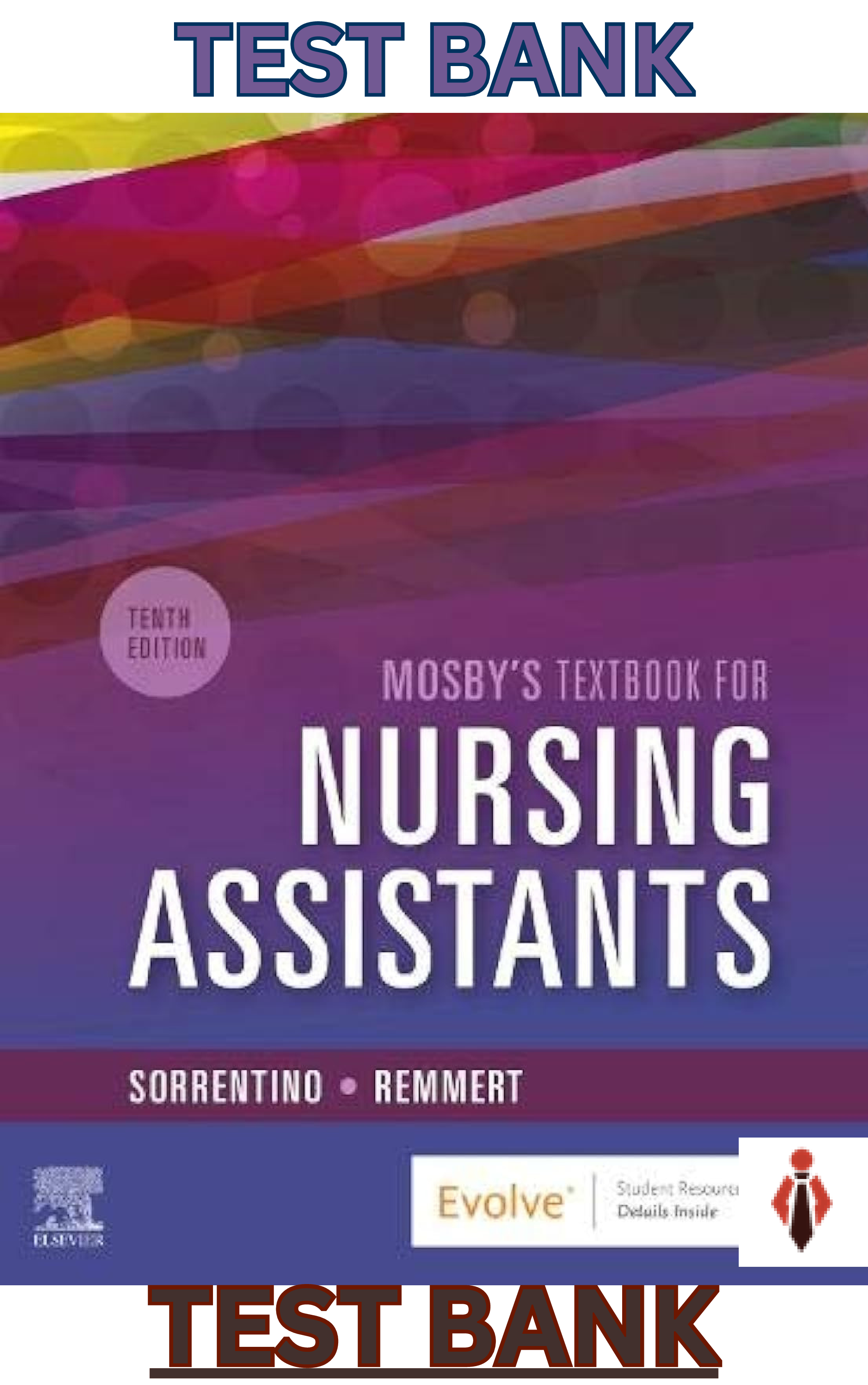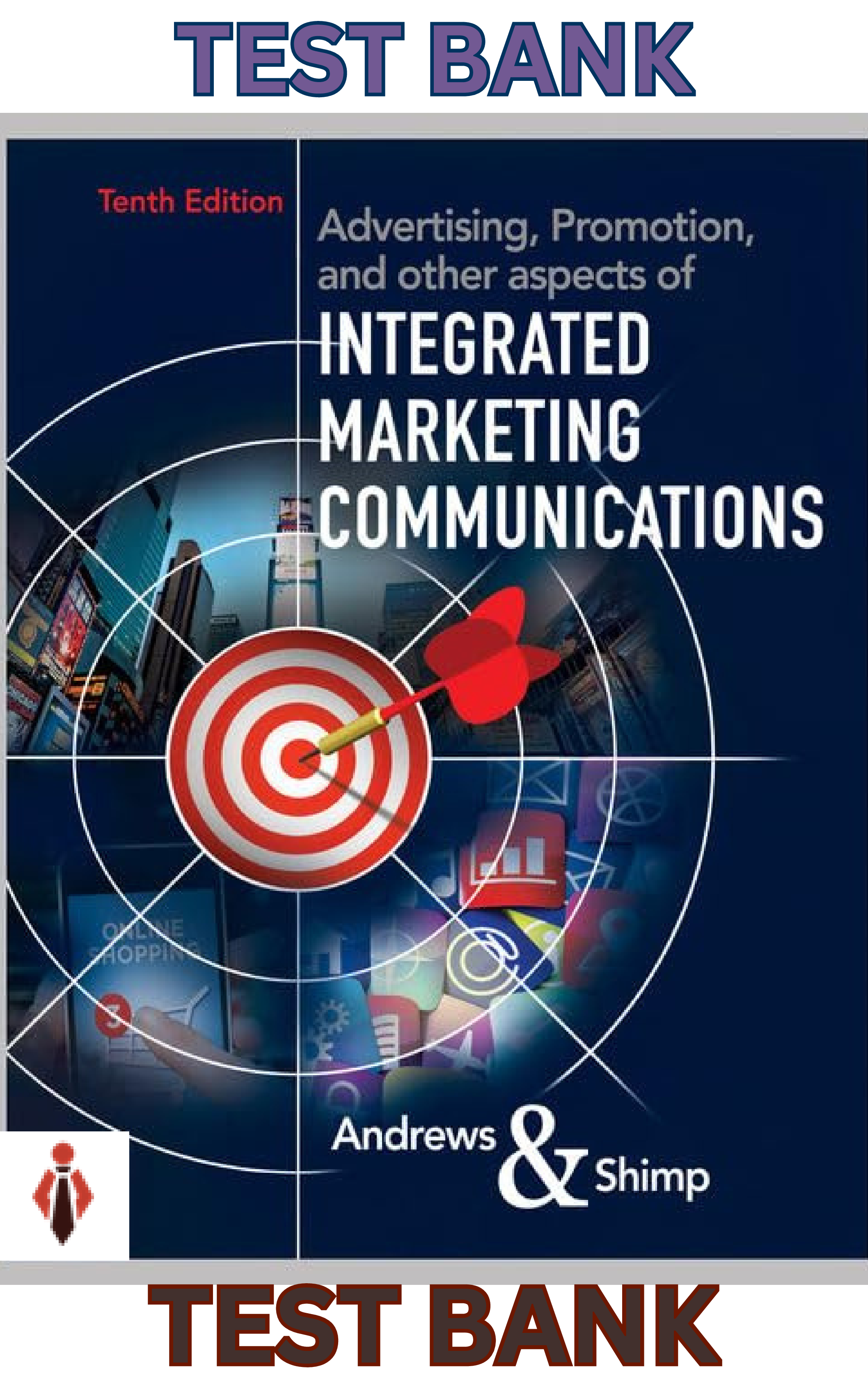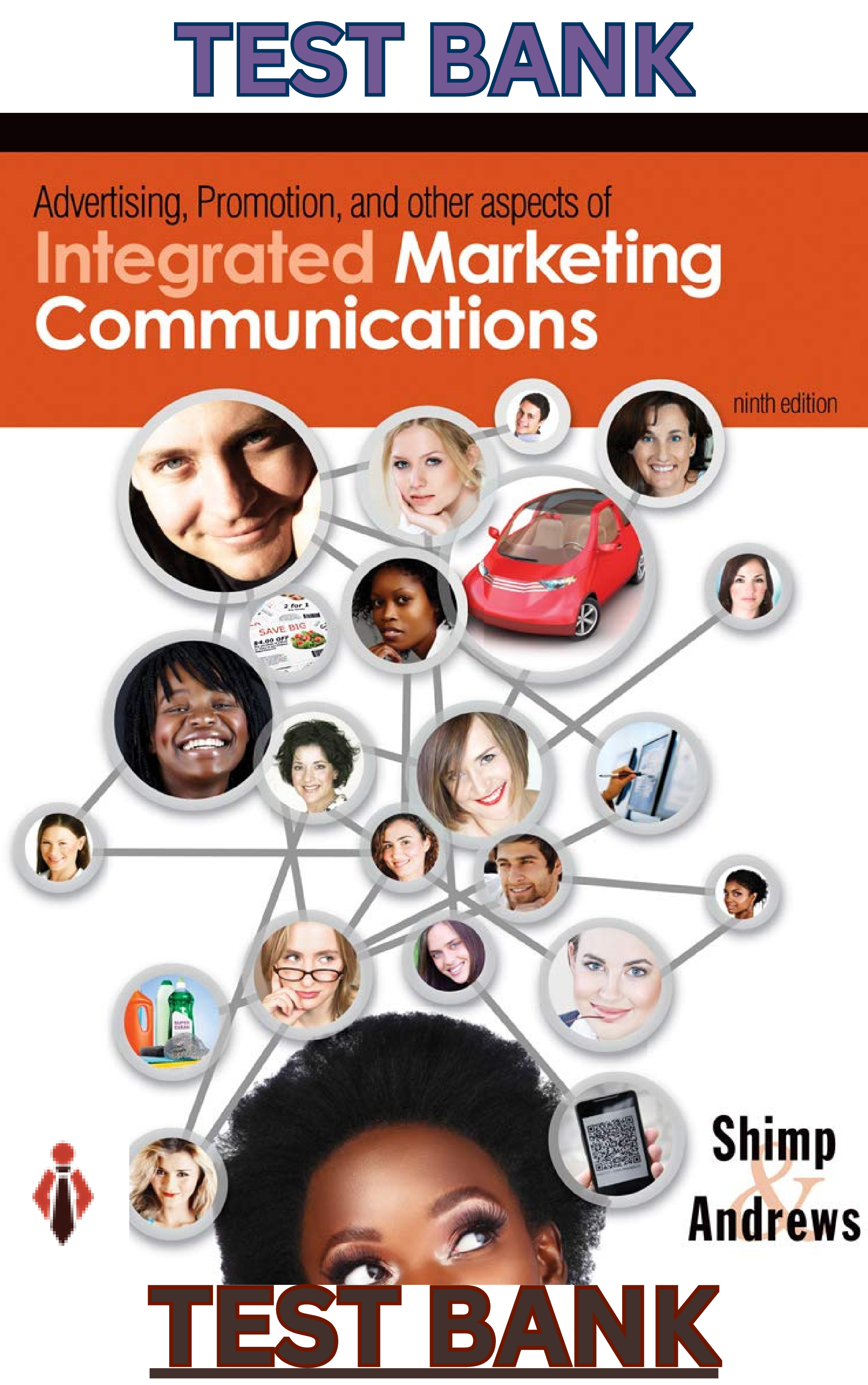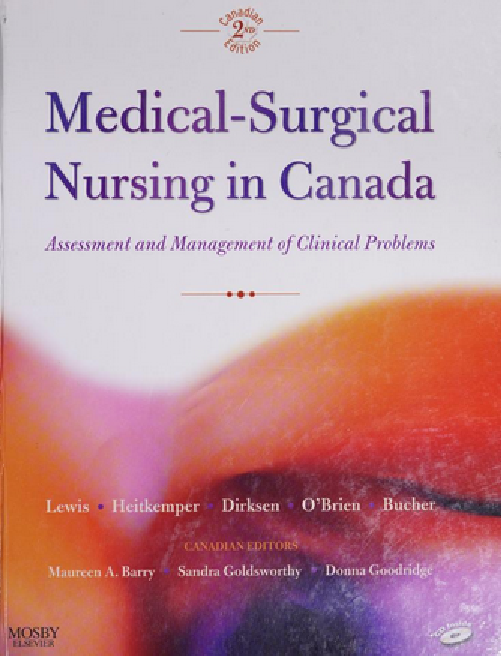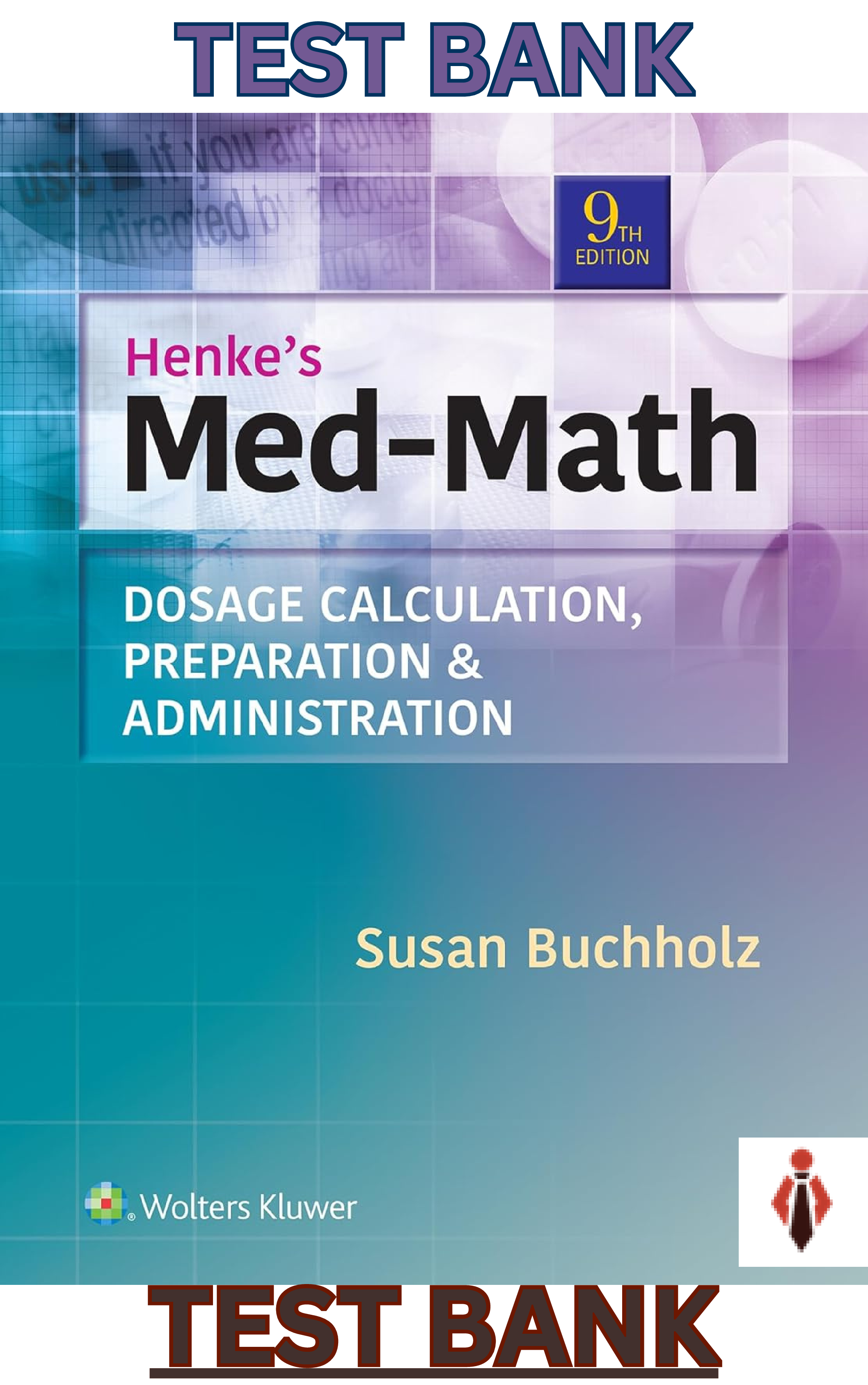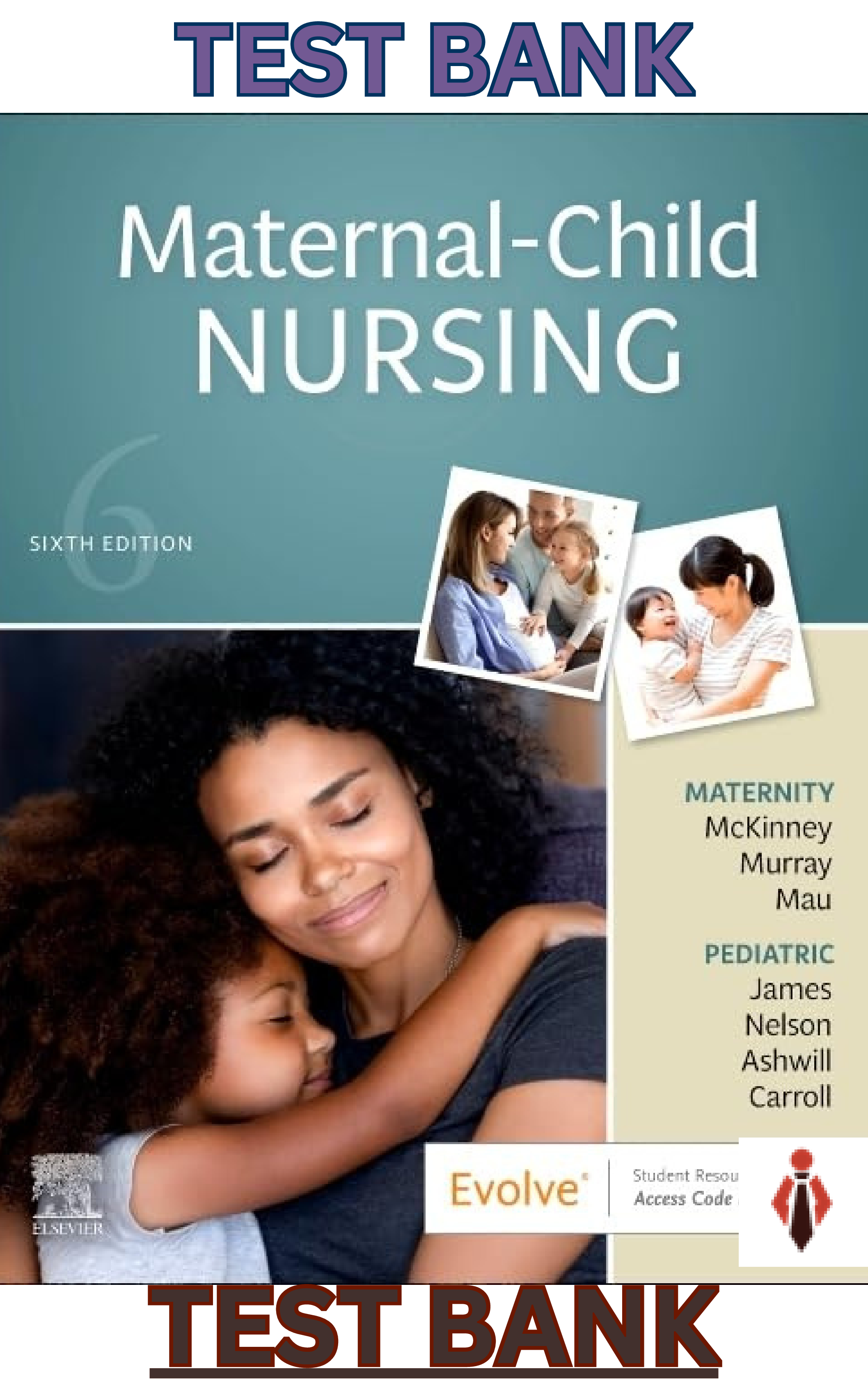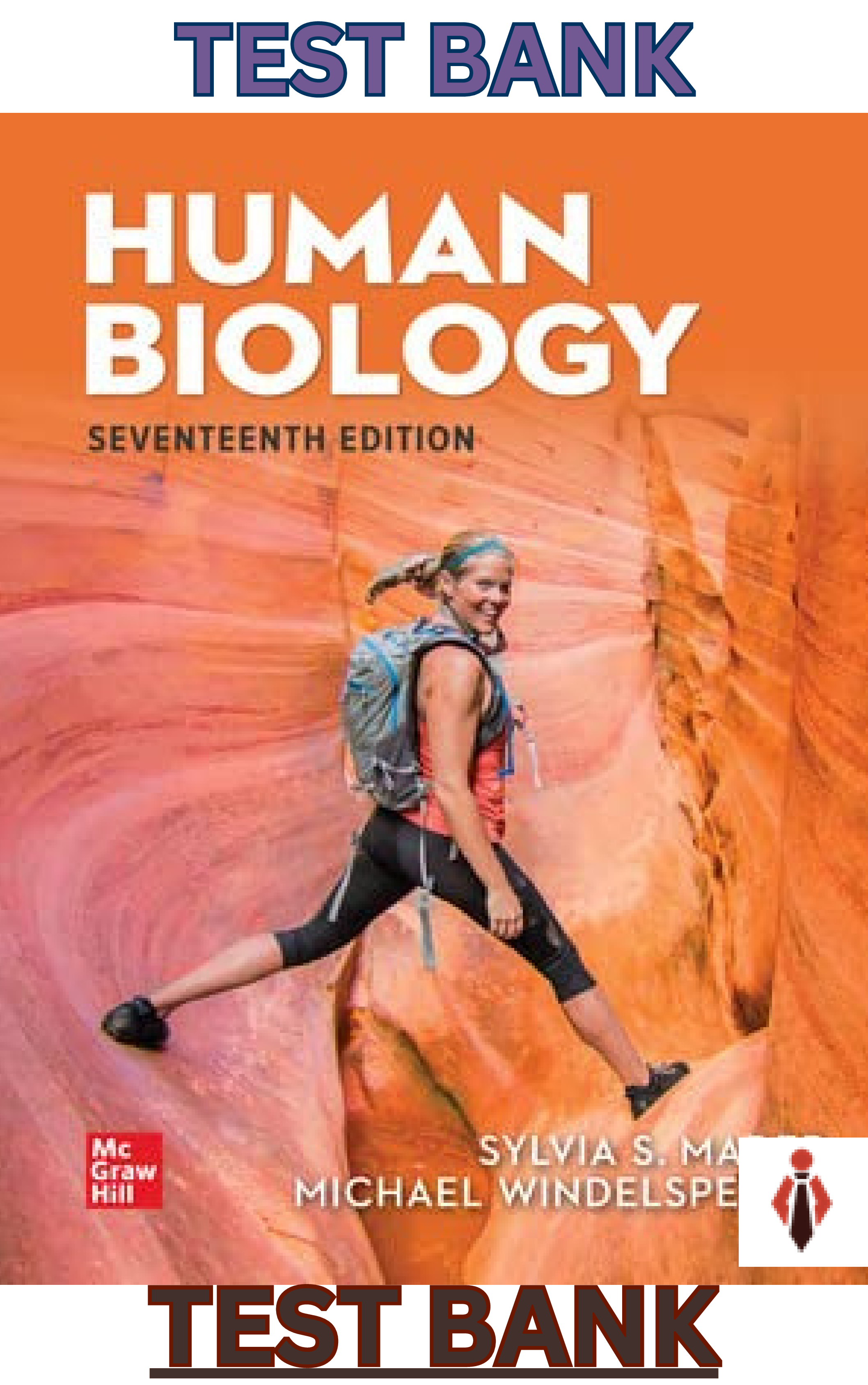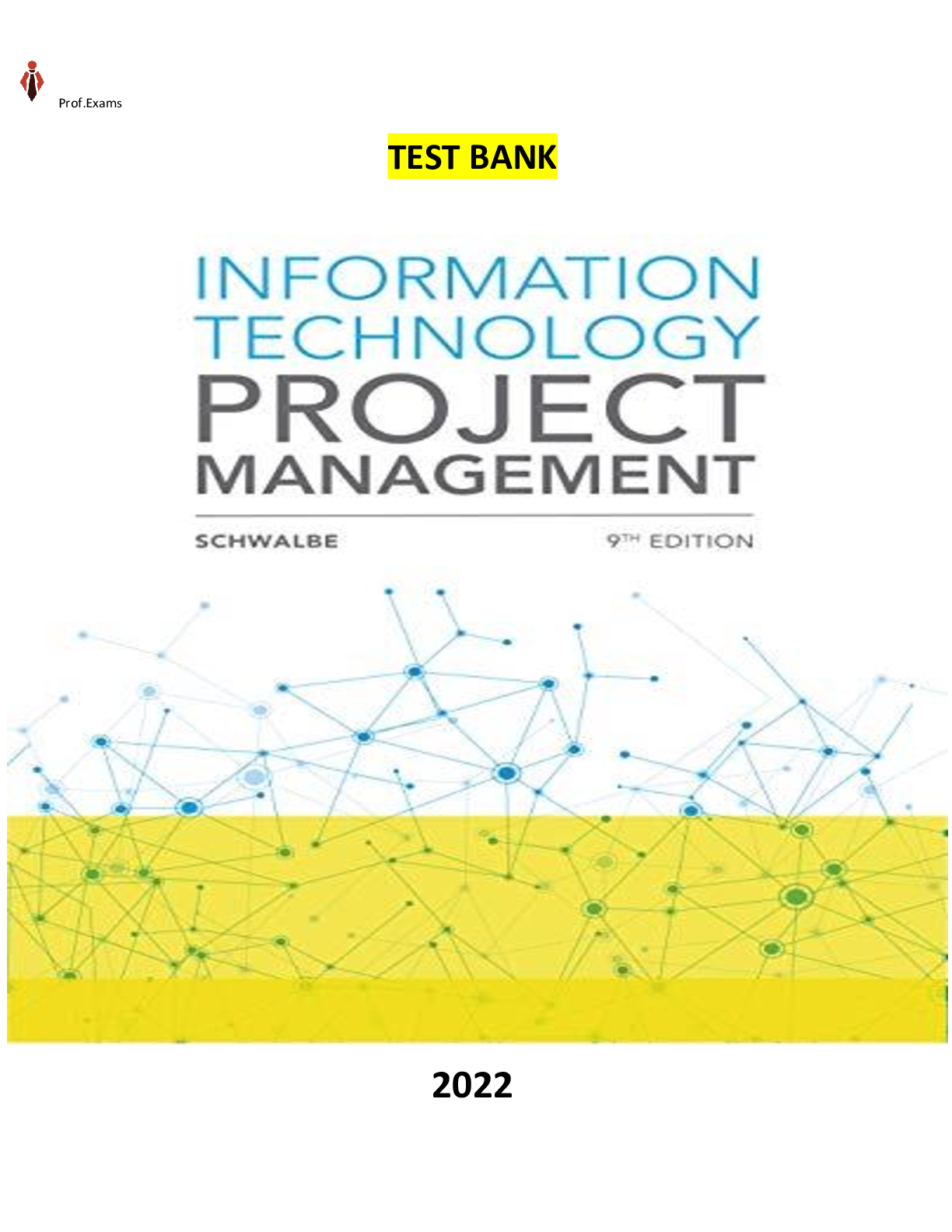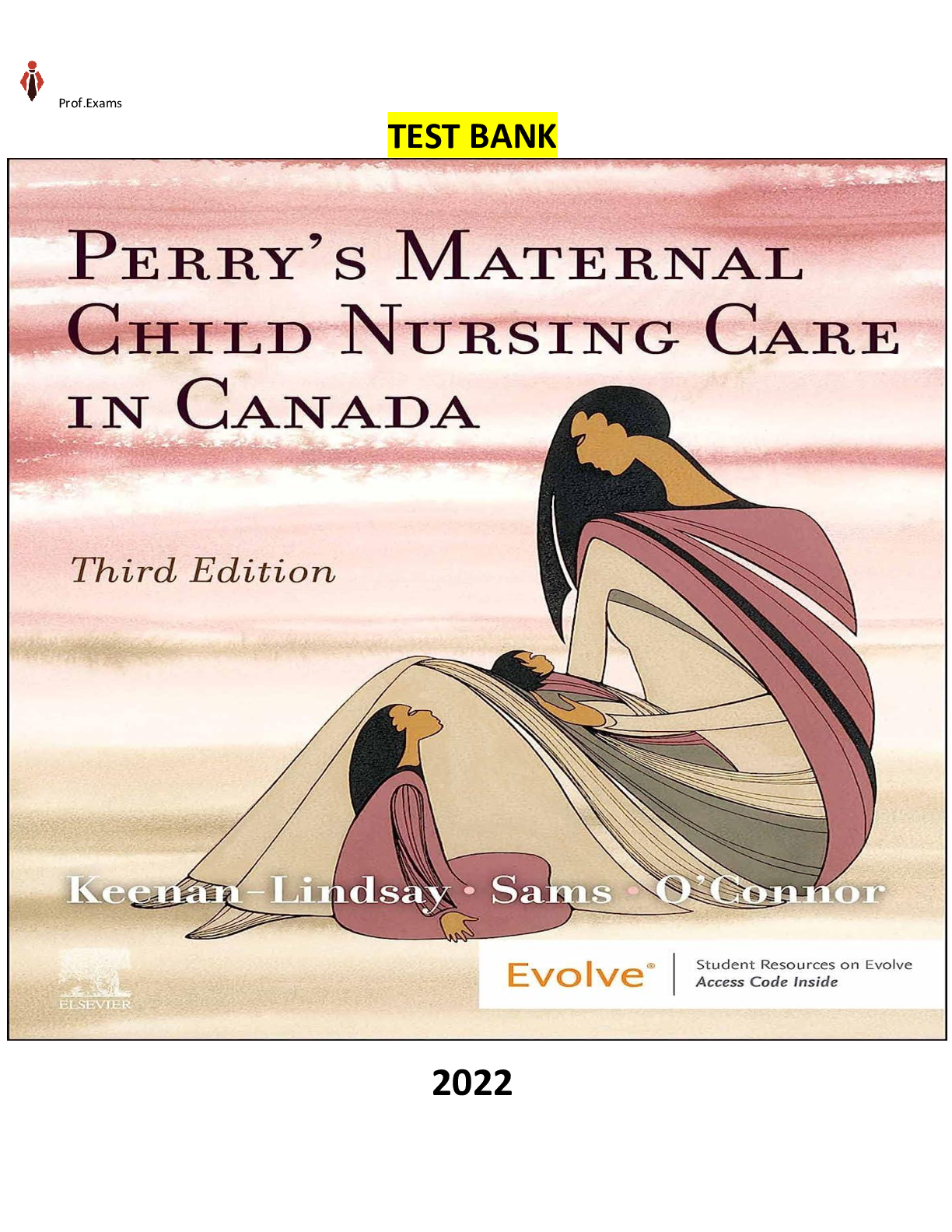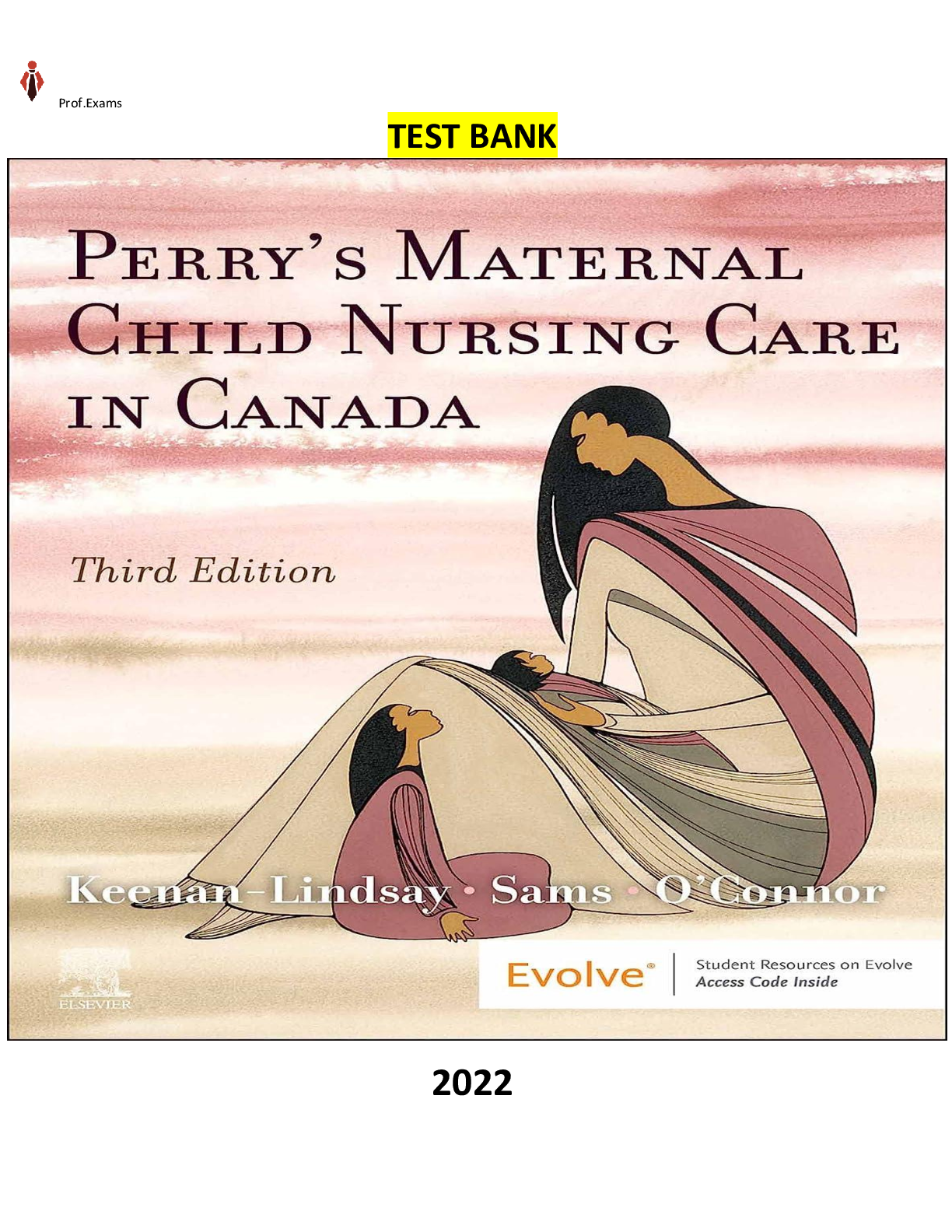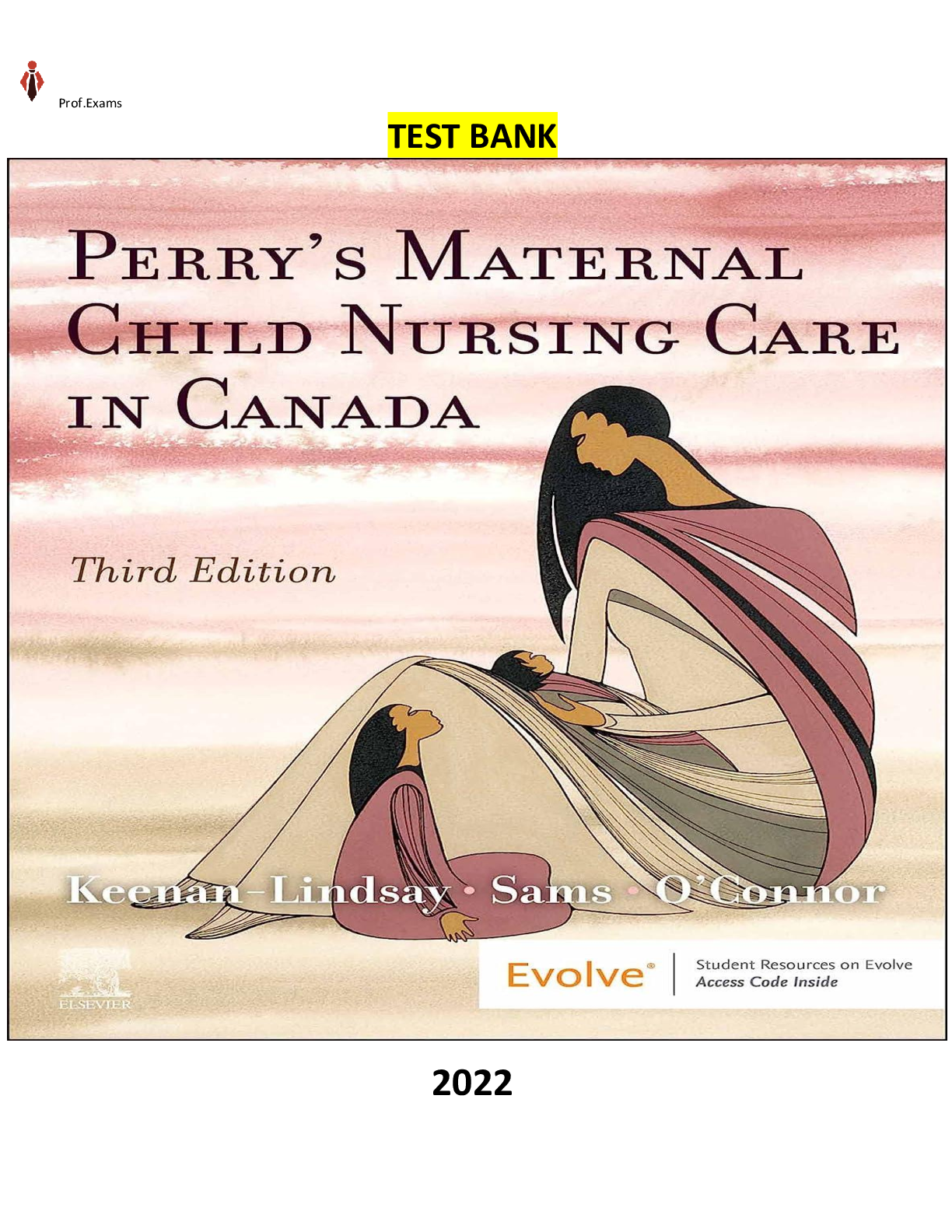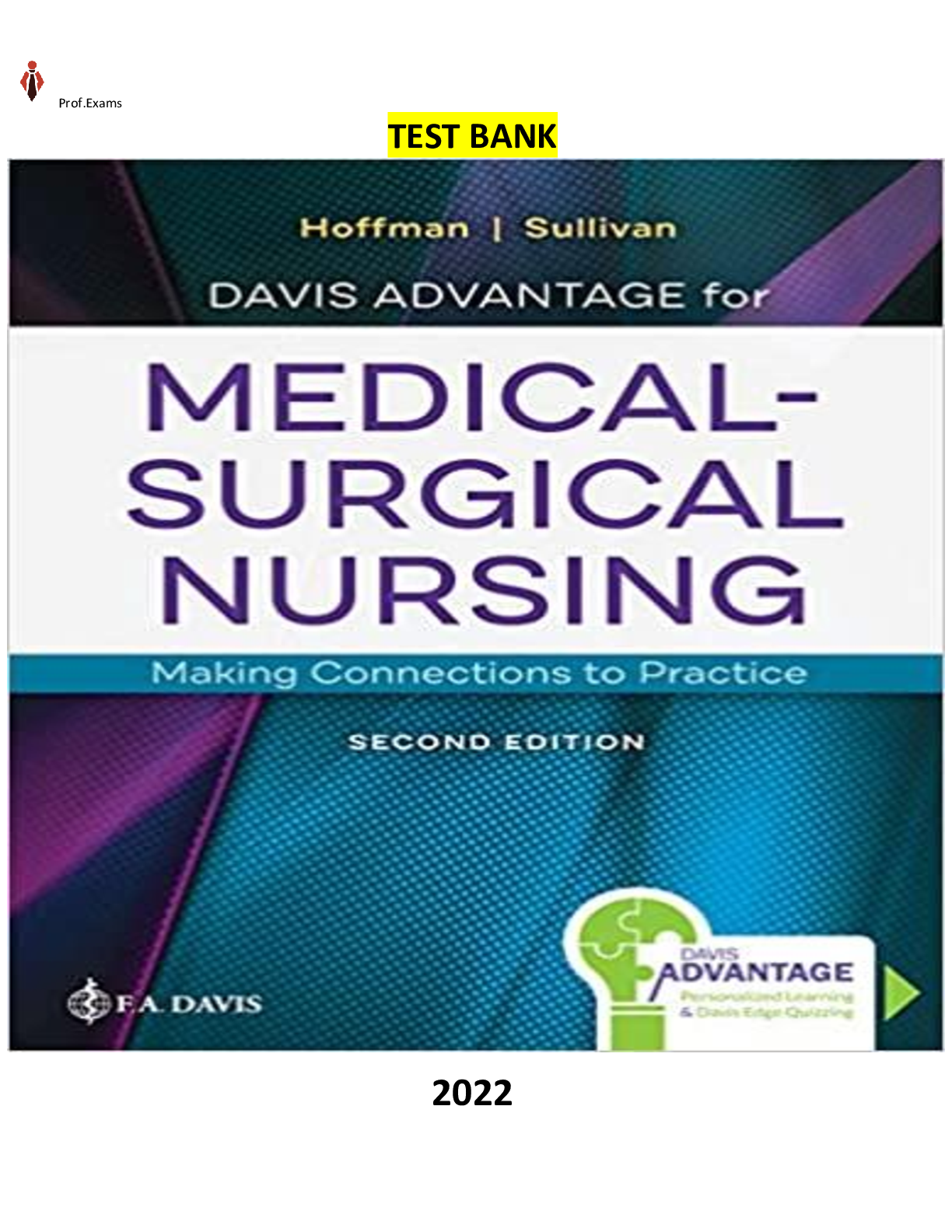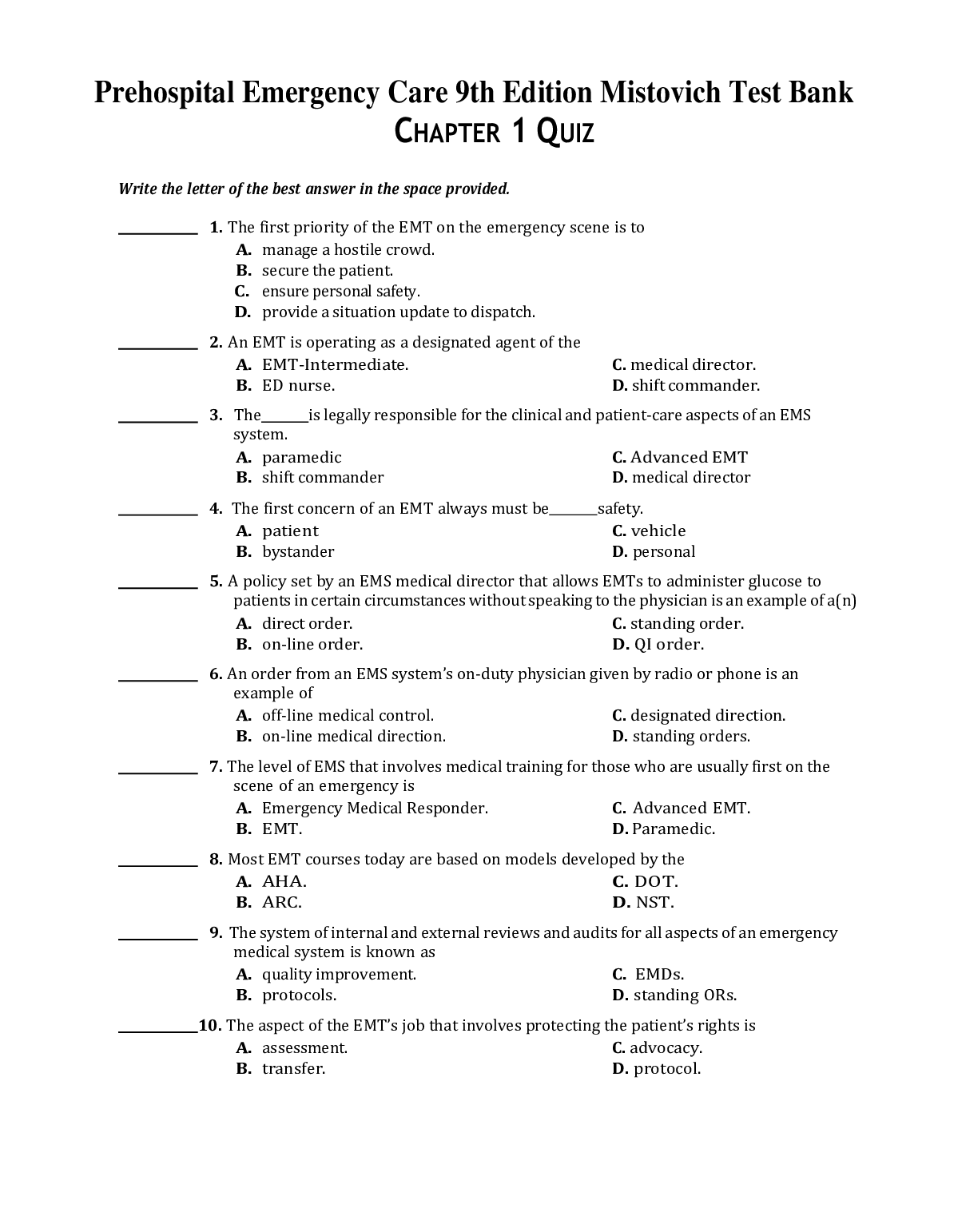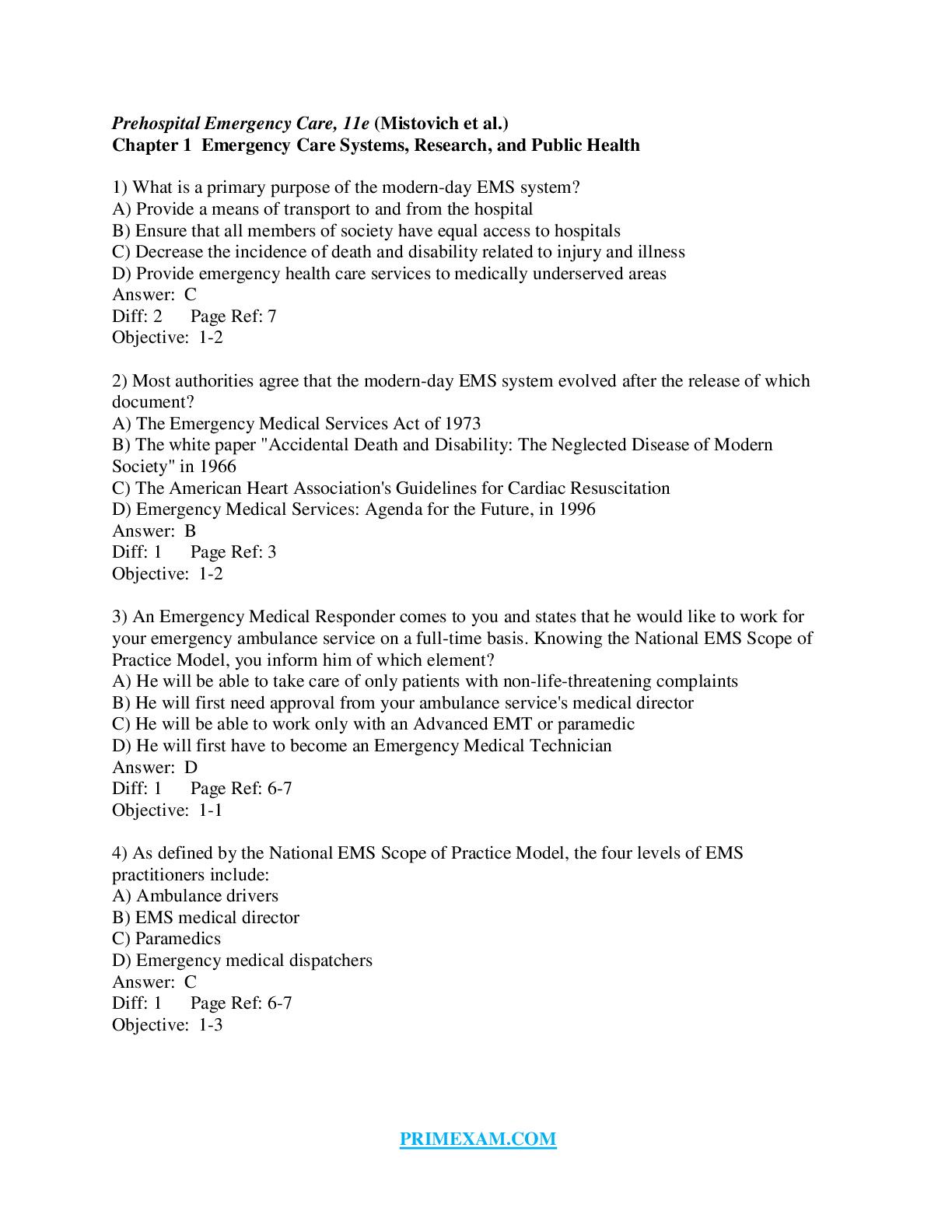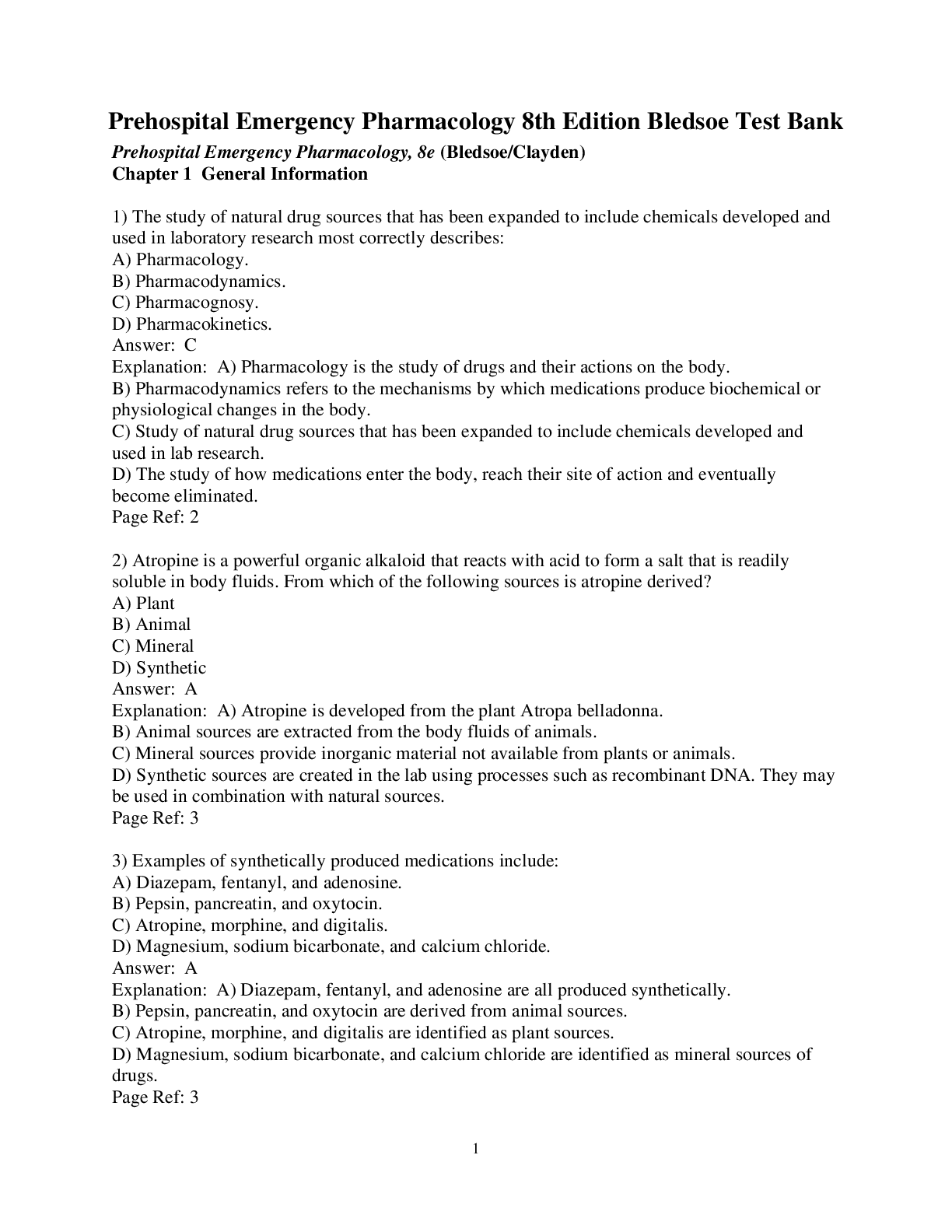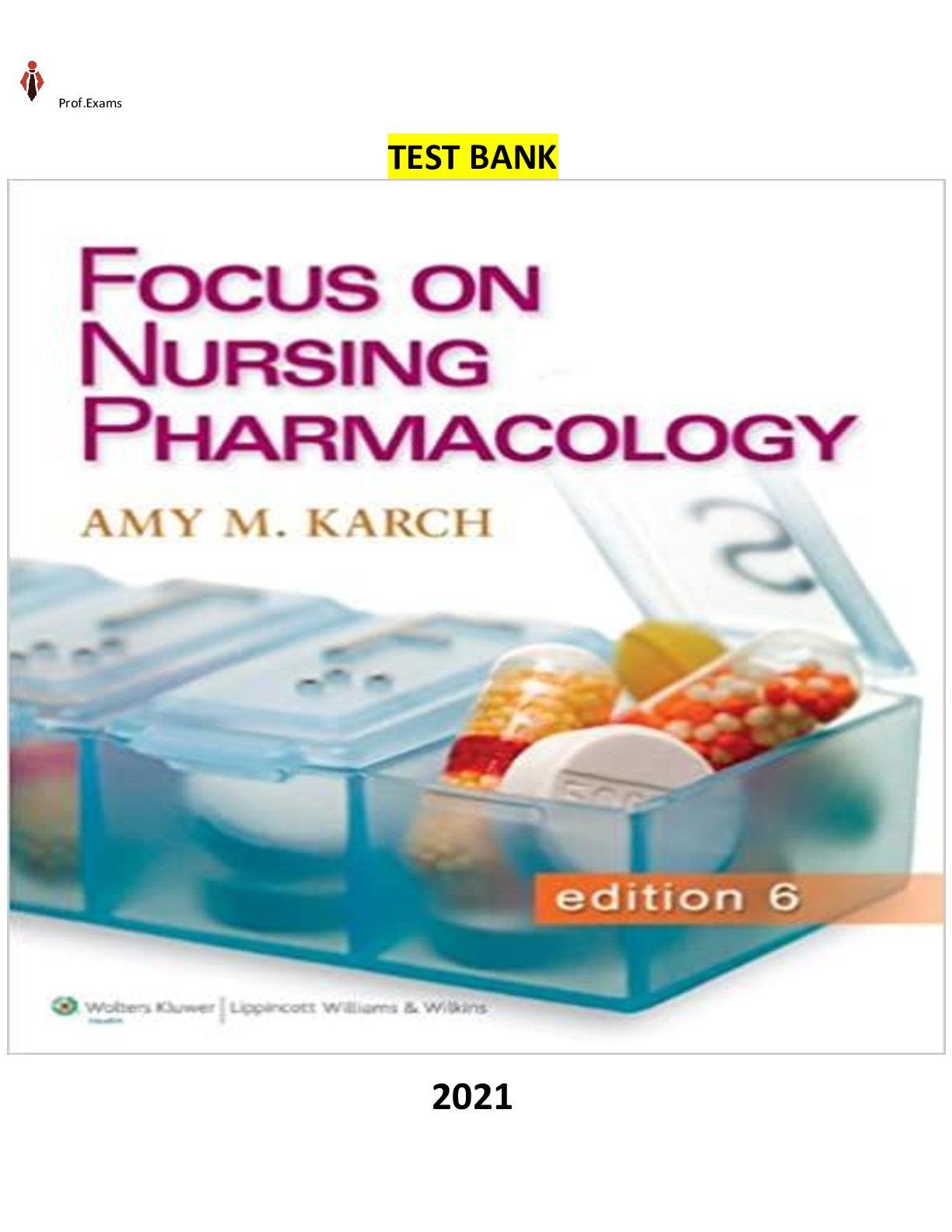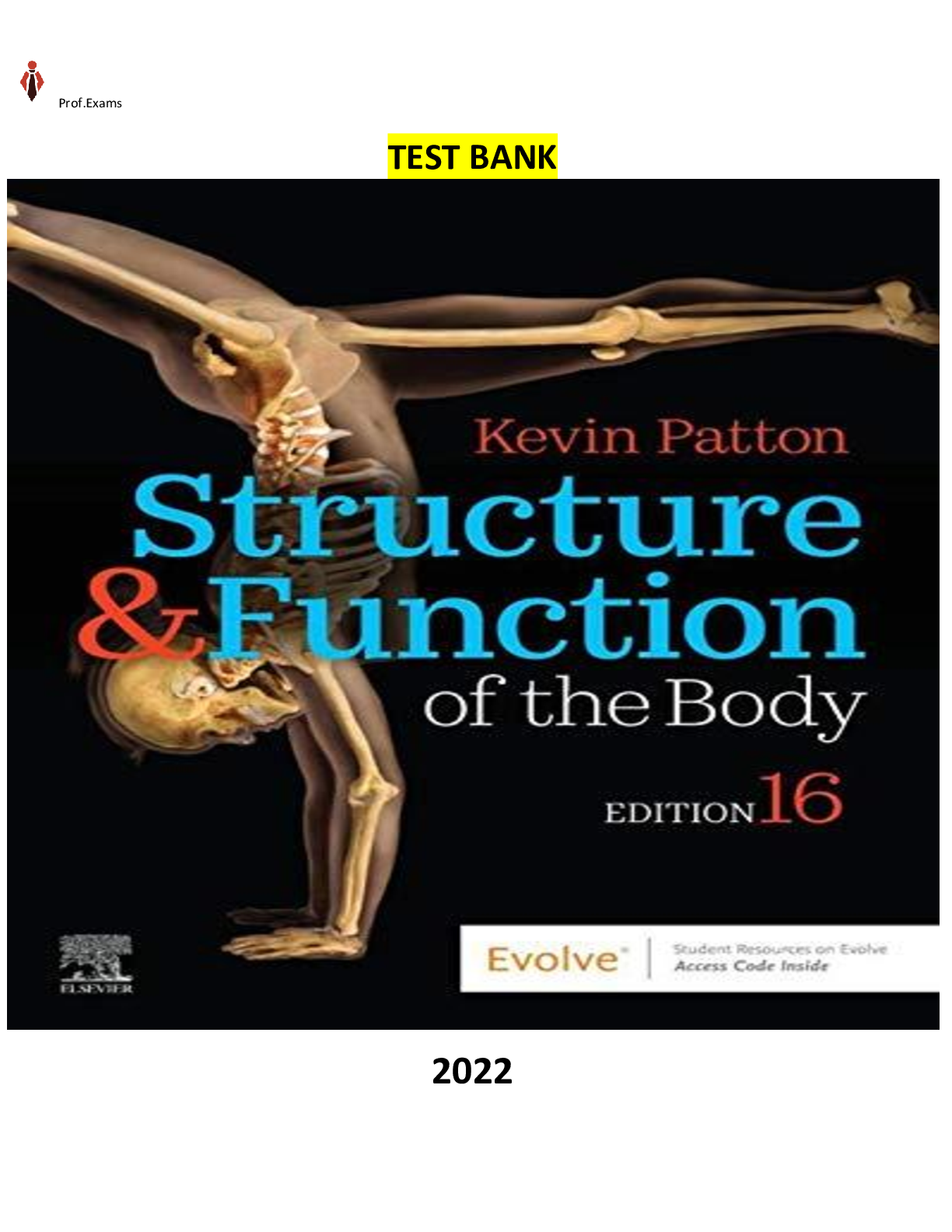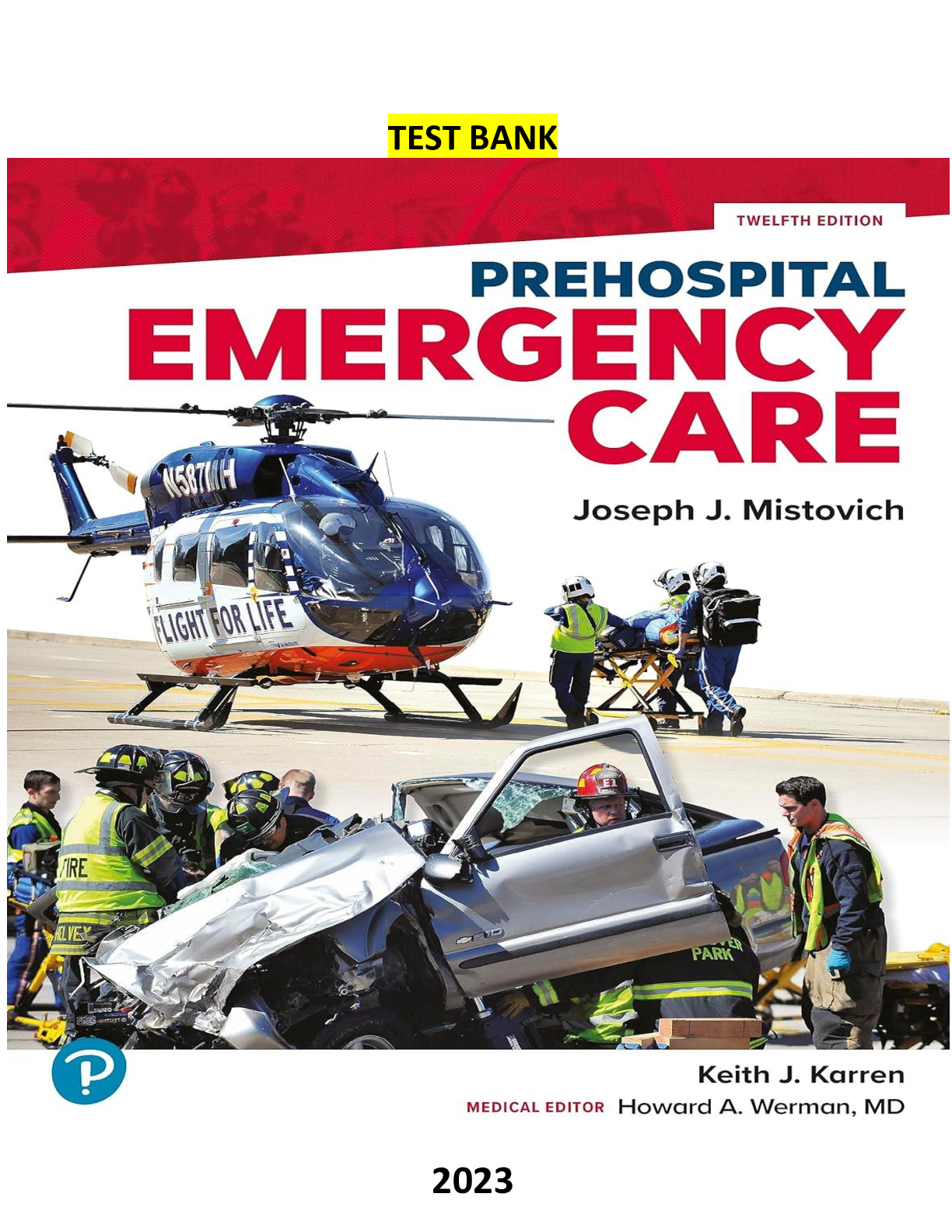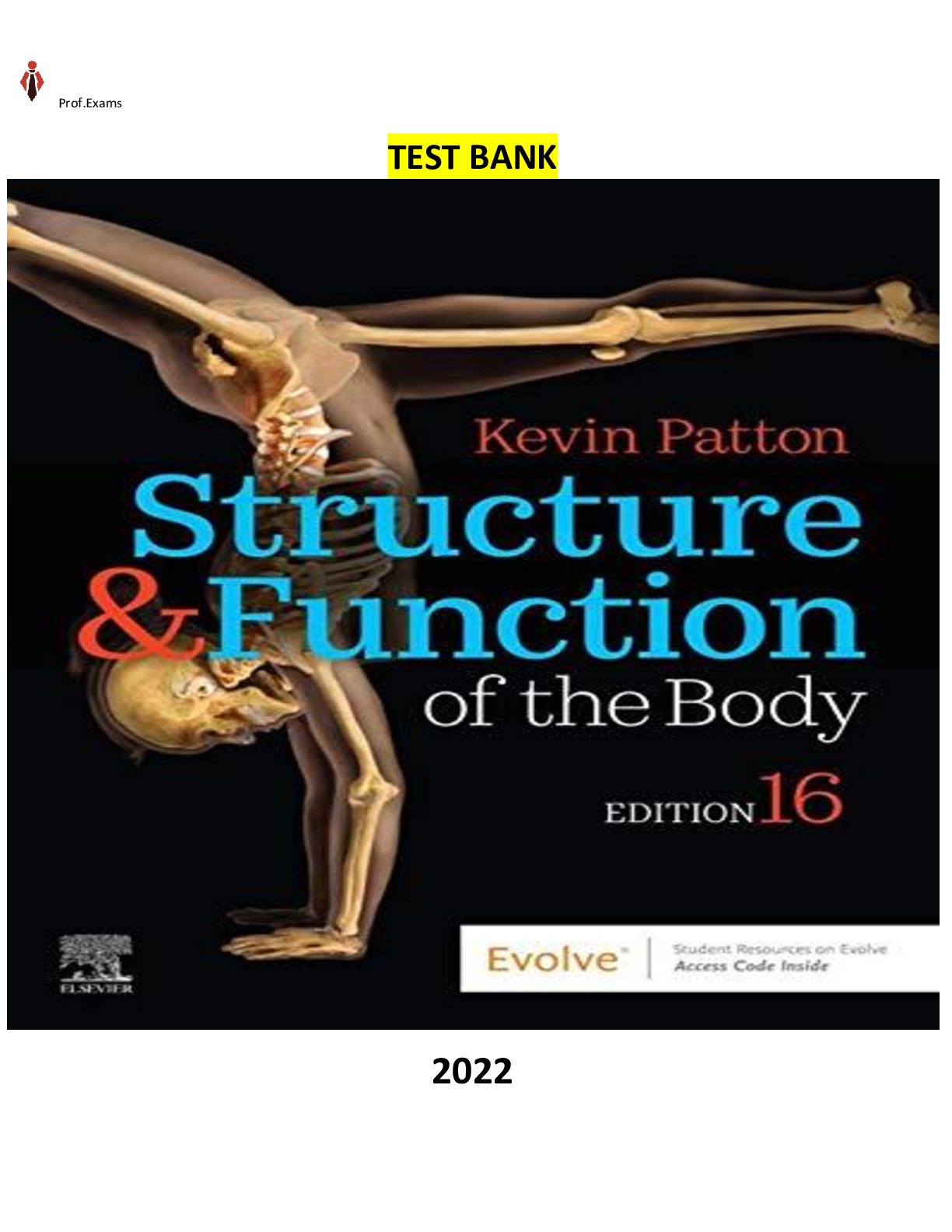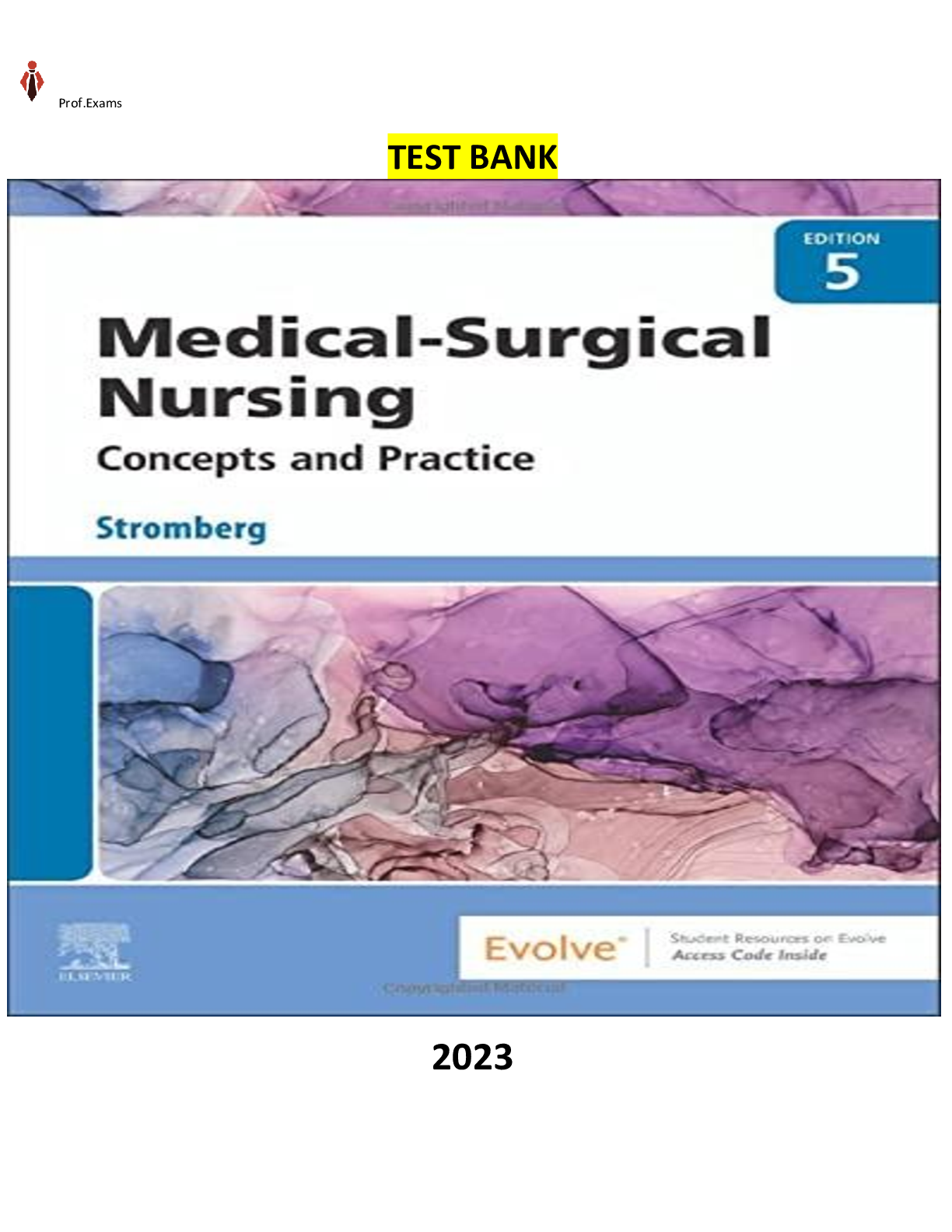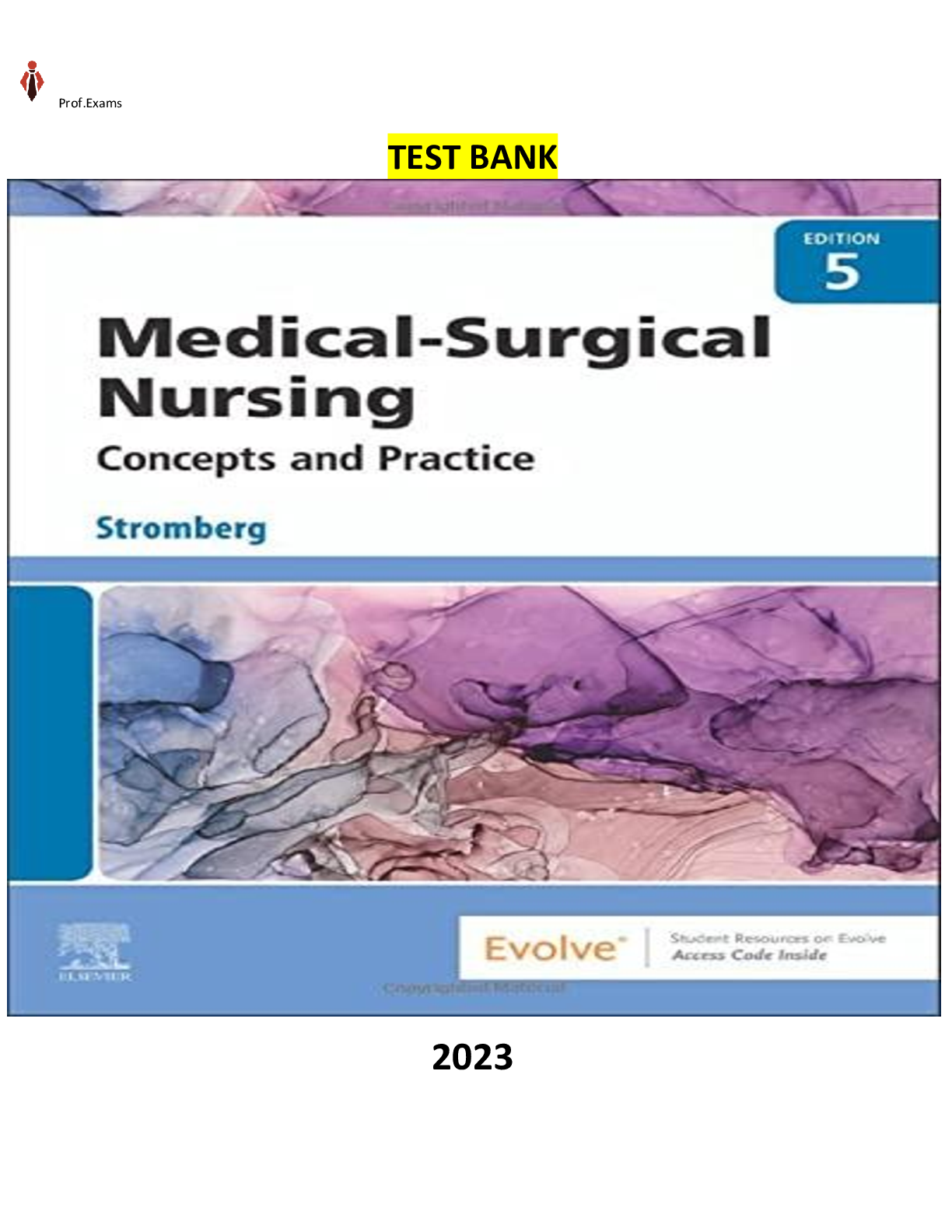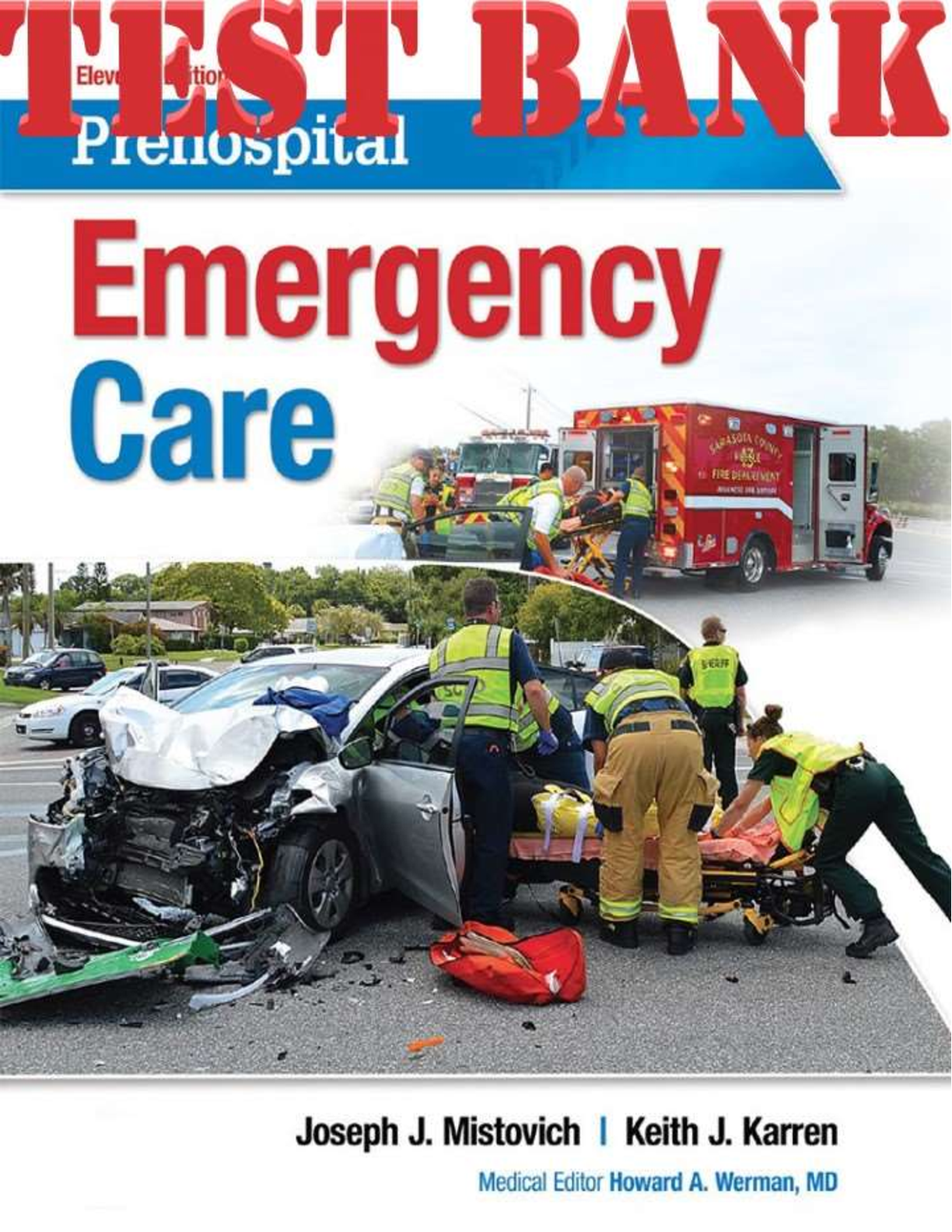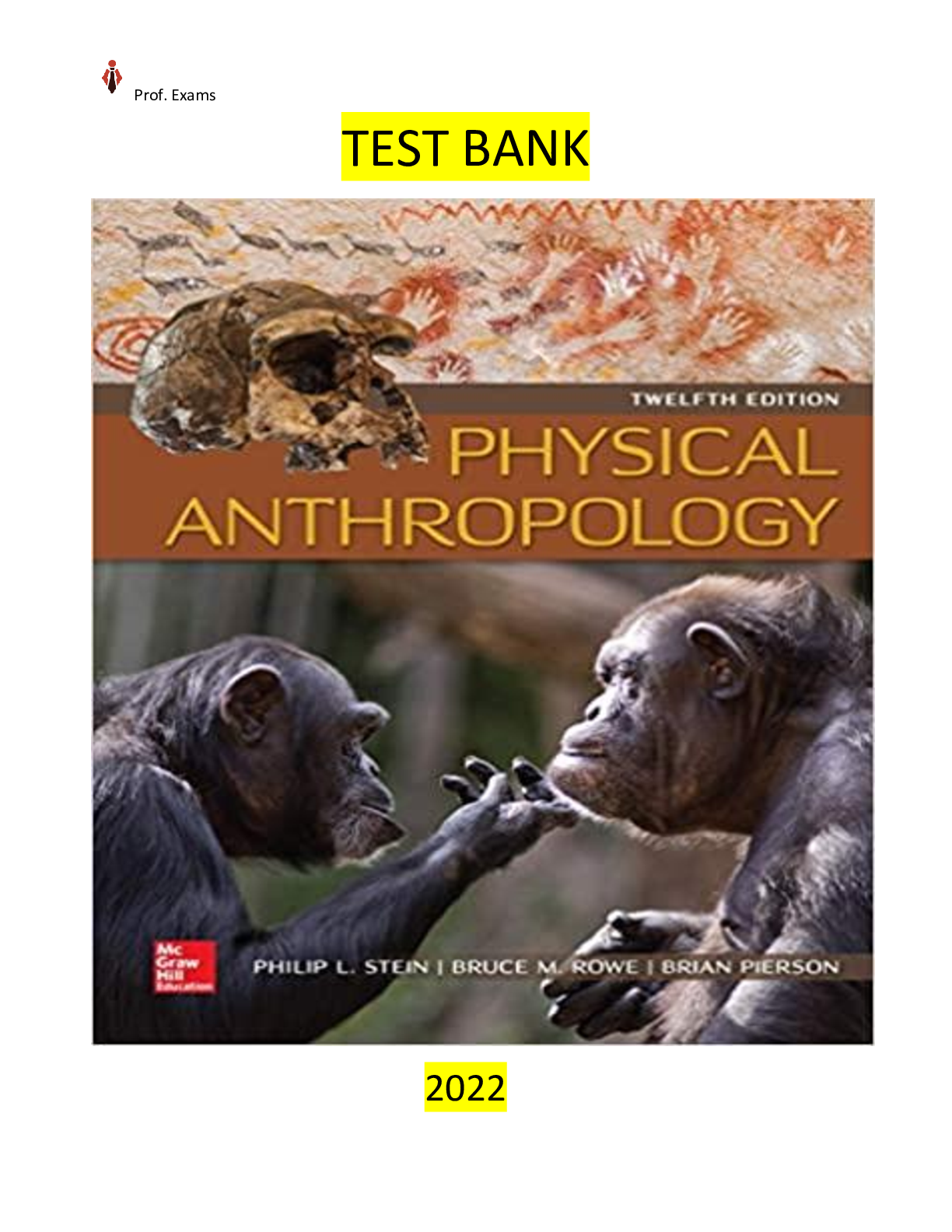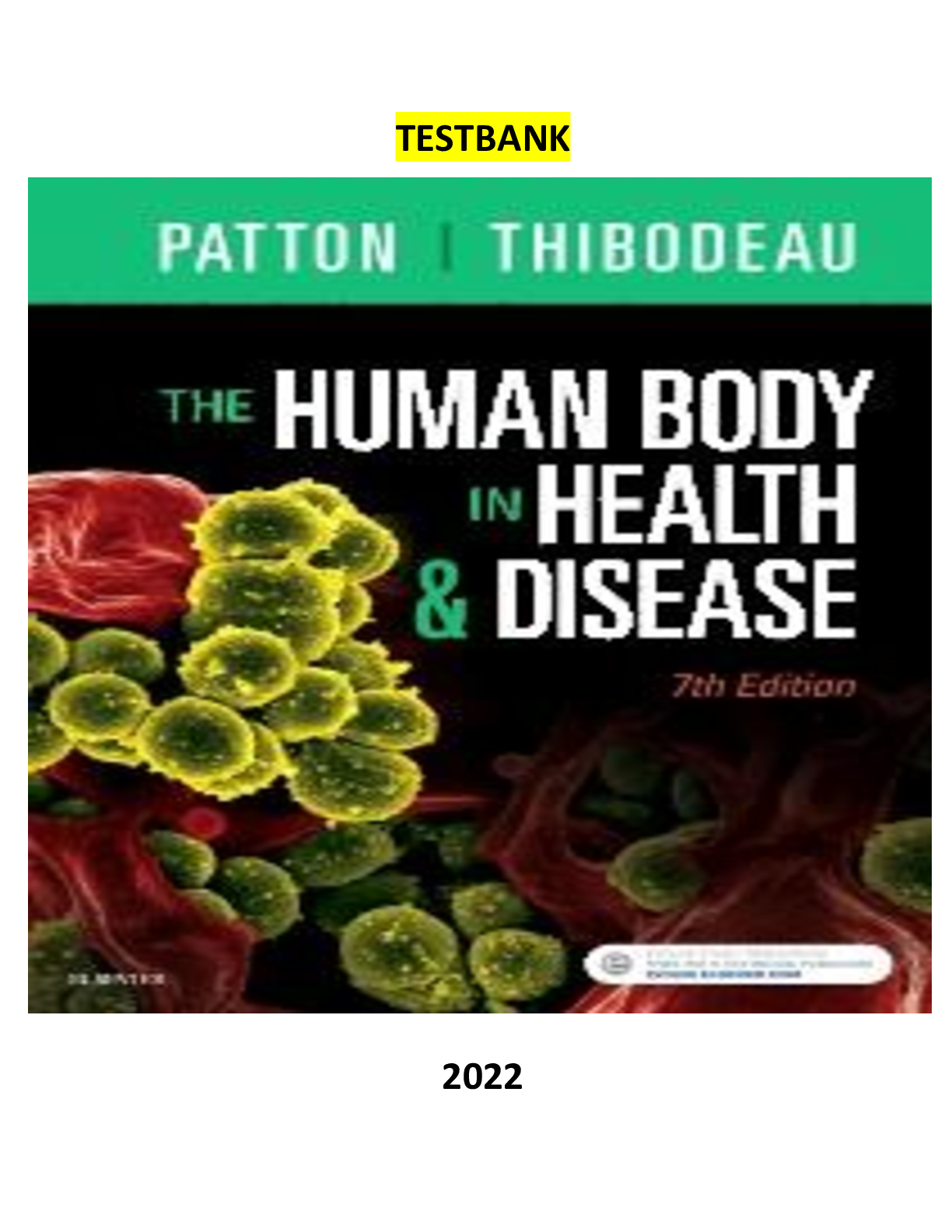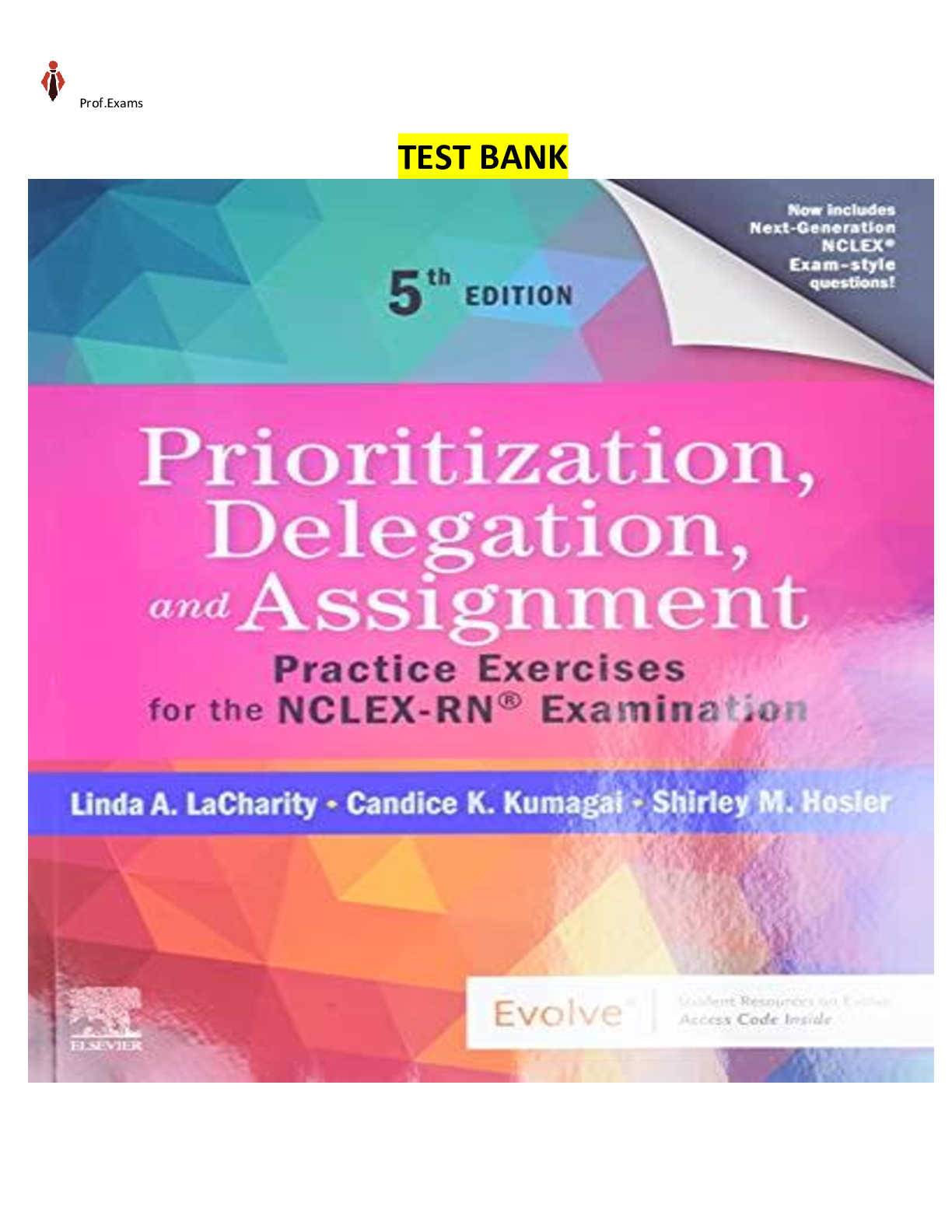Emergency Medicine > TEST BANK > COMPLETE - Elaborated Test Bank for Prehospital Emergency Care 12Ed. by Joseph Mistovich, Keith Karr (All)
COMPLETE - Elaborated Test Bank for Prehospital Emergency Care 12Ed. by Joseph Mistovich, Keith Karren & Howard A.Werman ALL Chapters included updated & Latest-2022
Document Content and Description Below
COMPLETE - Elaborated Test Bank for Prehospital Emergency Care 12Ed. by Joseph Mistovich, Keith Karren & Howard A.Werman ALL Chapters included updated & Latest-2022 COMPLETE - Elaborated Test Bank ... for Prehospital Emergency Care 12Ed. by Joseph Mistovich, Keith Karren & Howard A.Werman ALL Chapters included updated & Latest-2022 CONTENTS PART 1: PREPARATORY AND PUBLIC HEALTH 1. Emergency Medical Service Systems, Research, and Public Health 2. Workforce Safety and Wellness of the EMT 3. Medical, Legal, and Ethical Issues 4. Documentation 5. Communication 6. Lifting and Moving Patients PART 2: ANATOMY, PHYSIOLOGY, AND MEDICAL TERMINOLOGY 7. Anatomy, Physiology, and Medical Terminology PART 3: PATHOPHYSIOLOGY 8. Pathophysiology PART 4: LIFE SPAN DEVELOPMENT 9. Life Span Development PART 5: AIRWAY MANAGEMENT, RESPIRATION, VENTILATION, AND OXYGENATION 10. Airway Management, Respiration, Ventilation, and Oxygenation PART 6: ASSESSMENT 11. Vital Signs, Monitoring Devices, and History Taking 12. Scene Size-Up 13. Patient Assessment PART 7: GENERAL PHARMACOLOGY AND MEDICATION ADMINISTRATION 14. General Pharmacology and Medication Administration PART 8: SHOCK AND RESUSCITATION 15. Shock and Resuscitation PART 9: MEDICAL 16. Respiratory Emergencies 17. Cardiovascular Emergencies Prof.Exams 18. Altered Mental Status, Stroke, and Headache 19. Seizures and Syncope 20. Acute Diabetic Emergencies 21. Allergic and Anaphylactic Reactions 22. Toxicologic Emergencies and Infectious Diseases 23. Abdominal, Hematologic, Gynecologic, Genitourinary, and Renal Emergencies 24. Environmental Emergencies 25. Submersion Incidents: Drowning and Diving Emergencies 26. Vulnerable Populations: Psychiatric Emergencies and Psychosocial Issues PART 10: TRAUMA 27. Trauma Overview: The Trauma Patient and the Trauma System 28. Bleeding and Soft Tissue Trauma 29. Burns 30. Musculoskeletal Trauma and Nontraumatic Fractures 31. Head Trauma 32. Spinal Injury and Spine Motion Restriction 33. Eye, Face, and Neck Trauma 34. Chest Trauma 35. Abdominal and Genitourinary Trauma 36. Multisystem Trauma and Trauma in Special Patient Populations PART 11: SPECIAL PATIENT POPULATIONS 37. Obstetrics and Neonatal Care 38. Patients with Special Challenges 39. The Combat Veteran PART 12: EMS OPERATIONS 40. Ambulance Operations and Air Medical Response 41. Gaining Access and Patient Extrication 42. Hazardous Materials 43. Multiple-Casualty Incidents and Incident Management 44. EMS Response to Terrorist Incidents and High Threat and Active Shooter Incidents Prehospital Emergency Care, 12e (Mistovich et al.) Chapter 1 Emergency Care Systems, Research, and Public Health 1) What is a primary purpose of the modern-day EMS system? A) Provide a means of transport to and from the hospital B) Ensure that all members of society have equal access to hospitals C) Decrease the incidence of death and disability related to injury and illness D) Provide emergency health care services to medically underserved areas Answer: C Diff: 2 Page Ref: 7 Objective: 1-2 2) Most authorities agree that the modern-day EMS system evolved after the release of which document? A) The Emergency Medical Services Act of 1973 B) The white paper "Accidental Death and Disability: The Neglected Disease of Modern Society" in 1966 C) The American Heart Association's Guidelines for Cardiac Resuscitation D) Emergency Medical Services: Agenda for the Future, in 1996 Answer: B Diff: 1 Page Ref: 3 Objective: 1-2 3) An Emergency Medical Responder comes to you and states that he would like to work for your emergency ambulance service on a full-time basis. Knowing the National EMS Scope of Practice Model, you inform him of which element? A) He will be able to take care of only patients with non-life-threatening complaints B) He will first need approval from your ambulance service's medical director C) He will be able to work only with an Advanced EMT or paramedic D) He will first have to become an Emergency Medical Technician Answer: D Diff: 1 Page Ref: 6-7 Objective: 1-1 4) As defined by the National EMS Scope of Practice Model, the four levels of EMS practitioners include: A) Ambulance drivers B) EMS medical director C) Paramedics D) Emergency medical dispatchers Answer: C Diff: 1 Page Ref: 6-7 Objective: 1-3 2 Copyright © 2021 Pearson Education, Inc. Prof.Exams 5) An Emergency Medical Responder (EMR) approaches you and states that he is interested in becoming an EMT. Specifically, he asks what he will be able to do as an EMT that he cannot presently do as an EMR. You respond by saying he will be able to: A) Administer some medications B) Assist in emergency childbirth C) Use an automated external defibrillator D) Obtain vital signs Answer: A Diff: 1 Page Ref: 6-7 Objective: 1-5 6) You have been dispatched for a 61-year-old female in cardiac arrest. Emergency Medical Responders (EMRs) are on scene. In your community, all EMS practitioners are trained according to the National EMS Scope of Practice Model. Given this, which type of care do you expect the EMRs to be providing? A) Emergency medication administration B) Automated external defibrillation C) Intravenous therapy D) Reading an electrocardiogram Answer: B Diff: 2 Page Ref: 6 Objective: 1-5 7) An EMT with your service states that she desires to become a paramedic because she wants to provide advanced care. Under the National EMS Scope of Practice Model, which one of these types of care will she be able to provide as a paramedic that she cannot provide as an EMT? A) Automated blood pressure monitoring B) Assistance with emergency childbirth C) Interfacility transports D) IV therapy Answer: D Diff: 1 Page Ref: 7 Objective: 1-5 8) Which statement made by an EMT requires immediate intervention by a superior or the service supervisor? A) "I always wear my seat belt whenever I am in the patient compartment of the ambulance, unless I have to remove it to care for a patient." B) "I drive as fast as I can to get to the scene of an emergency, especially if a child is sick or injured according to dispatch information." C) "When I am driving with lights and sirens, I instruct my partner that he will need to handle all radio communications." D) "I put exam gloves on for every patient I contact, even if he or she does not have a known or suspected infectious disease." Answer: B Diff: 1 Page Ref: 9 Objective: 1-7 3 Copyright © 2021 Pearson Education, Inc. Prof.Exams 9) Which statement shows that the EMT has a good understanding of her role and responsibilities related to being an EMT? A) "The patient's needs come before anyone else's needs." B) "At the scene of an emergency, my responsibility is to get to the patient no matter what." C) "My safety comes first, and then the patient's safety." D) "As an EMT, I recognize that the public's safety comes before the safety of me or my partner." Answer: C Diff: 2 Page Ref: 8-9 Objective: 1-7 10) An ambulance with two EMTs arrives in front of a house for an unknown medical emergency. On scene, bystanders report that a female patient was beaten by her husband in the driveway and then dragged back into the house. They state that the patient appeared unconscious and was bleeding from the head. Which action would the EMTs perform next? A) Do not enter the scene until it has been controlled by law enforcement B) Quietly enter the home and quickly move the patient to the ambulance C) Remove the husband from the house, then provide emergency care to the wife D) Enter the home to protect the patient while waiting for the police to arrive Answer: A Diff: 2 Page Ref: 9 Objective: 1-7 11) Why is EMS in a unique position to contribute significantly to mobile integrated health care? A) EMS providers are familiar with and capable of functioning in the out-of-hospital environment B) Ambulances are easily identified C) The community trusts uniformed health care providers D) EMS providers are familiar with the many routes of medication administration Answer: A Diff: 1 Page Ref: 17 Objective: 1-15 4 Copyright © 2021 Pearson Education, Inc. Prof.Exams 12) You have arrived on the scene of a motor vehicle collision. A car has gone off the road and into a utility pole. The pole is broken and wires are hanging just above the car. You do not see any sparking or arcing of the wires. The driver of the car is slumped over the steering wheel and not moving. Several bystanders around the car are yelling for you to help. Which steps represent the correct order of your response? A) Clear the bystanders, allow the fire department to secure the wires, access the patient, extricate the patient, transport B) Access the patient, clear the bystanders, allow the fire department to secure the wires, extricate the patient, transport C) Clear the bystanders, access the patient, extricate the patient, transport, allow the fire department to secure the wires D) Access the patient, allow the fire department to secure the wires, clear the bystanders, extricate the patient, transport Answer: A Diff: 2 Page Ref: 8-9 Objective: 1-7 13) Once a scene is free of safety hazards, the EMT must recognize and focus on the needs of the: A) Rescuers B) Patient C) Family D) Bystanders Answer: B Diff: 1 Page Ref: 9 Objective: 1-7 14) You have been asked to sit on your service's quality improvement (QI) committee. As a knowledgeable EMT, you recognize that in this role you will be involved in projects that are primarily designed to: A) Communicate with insurance companies for increased reimbursement B) Recruit and educate EMTs about the Emergency Medical Services profession C) Develop ways in which the delivery of emergency care can be improved D) Identify and reeducate EMTs who routinely do not provide proper care Answer: C Diff: 2 Page Ref: 13 Objective: 1-10 15) What would be a logical project to be undertaken and developed by a quality improvement (QI) committee? A) Termination of EMTs who are chronically late to work B) A program by which pay raises are based on performance and attitude C) Community fundraiser to raise money for new EMS equipment D) Monthly continuing education programs in which seldom-used skills are practiced Answer: D Diff: 2 Page Ref: 14 Objective: 1-10 5 Copyright © 2021 Pearson Education, Inc. Prof.Exams 16) You are interviewing for the position of EMT with a busy urban service. This morning you are to meet with the service's medical director. You have been told that she likes it when applicants ask questions about her role as the medical director. Related to her responsibilities as medical director, which question is most appropriate? A) "How do you determine the wages that the EMTs are paid?" B) "How do you determine the number and location of ambulances within the system?" C) "How often are the emergency care protocols updated?" D) "Do you assign the daily chores that must be completed around the stations?" Answer: C Diff: 2 Page Ref: 12 Objective: 1-9 17) To be a medical director of an ambulance service, which requirement must the interested individual satisfy? A) Licensed physician B) Emergency physician with surgical experience C) Physician who was a paramedic D) Physician with a college degree in EMS Answer: A Diff: 1 Page Ref: 12 Objective: 1-9 18) As an EMT, which requirement must be met so that you can provide routine and emergency medical care to the sick and injured, as an extension of the medical director's authority? A) Prior medical experience B) A service medical director C) A knowledgeable partner D) A safe driving record Answer: B Diff: 1 Page Ref: 12 Objective: 1-9 19) It has been some time since you were involved in the care of a pediatric patient. You decide to review the assessment and treatment basics that your medical director requires. To review this information, which resource should you consult first? A) Emergency Medical Responders B) Reputable websites C) Emergency department nurses D) Service protocols Answer: D Diff: 1 Page Ref: 13 Objective: 1-9 6 Copyright © 2021 Pearson Education, Inc. Prof.Exams 20) Before the EMT contacts medical direction for authorization to assist a patient with shortness of breath in using her metered-dose inhaler, protocols state that the EMT must first attempt to provide relief by administering oxygen if the pulse oximeter reading is less than 94%. You recognize that the administration of oxygen is best described as a(n): A) Standing order B) On-line medical direction C) Direct permission D) Quality improvement Answer: A Diff: 2 Page Ref: 13 Objective: 1-9 21) If a patient with chest pain takes a daily aspirin, your medical director wants the EMT to contact an emergency department physician first before administering additional aspirin. The act of contacting the emergency department physician by phone or radio for permission to administer additional aspirin is an example of: A) Quality improvement B) On-line medical direction C) Off-line medical direction D) Indirect medical control Answer: B Diff: 2 Page Ref: 13 Objective: 1-1 22) At the scene of a minor motor vehicle collision, you are attending to a female patient who complains of head and neck pain. A crowd has gathered to watch the action. What will the observing public most likely remember about the role EMS portrayed? A) The number of emergency vehicles that showed up B) The color of the ambulances C) If the EMTs were all wearing the same color uniforms D) EMTs who were yelling and cursing loudly at the fire department to hurry up and get the patient out of the car Answer: D Diff: 2 Page Ref: 11 Objective: 1-8 23) You work in a community that has an "enhanced" 911 system. Given this, which is true about such a system? A) The physical location of the landline used to make the 911 call is displayed to the call taker B) The EMS system uses EMTs, Advanced EMTs, and paramedics C) The fire department responds simultaneously with EMS D) The total response time for EMS will rarely exceed 9 minutes Answer: A Diff: 1 Page Ref: 5 Objective: 1-4 7 Copyright © 2021 Pearson Education, Inc. Prof.Exams 24) Which patient would most benefit from calling an enhanced 911 system from the home phone? A) Patient with chest pain B) Patient with sudden onset of confusion C) Patient requiring advanced medical care D) Patient who cannot reach the phone Answer: B Diff: 2 Page Ref: 5 Objective: 1-4 25) A 14-year-old boy has fallen through a plate glass window and is bleeding heavily from a laceration to his arm. His panicked mother has called 911 for help. Since the 911 operators are also emergency medical dispatchers, what sort of assistance will they be able to provide? A) Simultaneous notification of the hospital B) Whether the EMS response is covered by medical insurance C) Instructions on how to control bleeding D) The names of the EMTs who are responding Answer: C Diff: 2 Page Ref: 5 Objective: 1-3 26) Which be an EMS public health initiative? A) Educating the public on the benefit of wearing seat belts B) Volunteering time to help raise money for a sick child and his family C) Providing volunteer emergency ambulance service 24 hours a day, 7 days a week D) Purchasing new equipment to better help those persons who experience a medical emergency Answer: A Diff: 2 Page Ref: 16 Objective: 1-14 27) Your service's medical director would like to explore the idea of EMTs using special transport ventilators when caring for patients who require assistance with their breathing. When using an evidence-based medicine approach, what should you do first? A) Go to a local hospital to see which kind of ventilators it uses B) Contact vendors that sell ventilators and ask for price quotations C) Select specific EMTs to conduct a field trial of particular ventilators D) Search the medical literature for research related to this topic Answer: D Diff: 2 Page Ref: 14 Objective: 1-13 8 Copyright © 2021 Pearson Education, Inc. Prof.Exams 28) You are by the side of a confused patient who has diabetes and a low blood sugar level. You know that the patient needs orally administered sugar, so following your service's guidelines, you call the physician on duty at the hospital emergency department and request permission to administer it. This request is an example of: A) Standing orders B) On-line medical direction C) Medical cooperation D) Off-line medical direction Answer: B Diff: 1 Page Ref: 12 Objective: 1-1 29) Which statement about emergency medical services in the United States is true? A) The EMS system is controlled and governed by the National Highway Transport and Safety Administration (NHTSA) B) The federal government oversees all aspects of EMS in the United States C) Each state has governmental control of its own EMS system, independent of the federal government D) The U.S. Department of Health and Human Services establishes curricula for all levels of EMS education Answer: C Diff: 2 Page Ref: 4 Objective: 1-3 30) The county dispatch center where you work employs emergency medical dispatchers (EMDs) as call takers. Using EMDs as opposed to a person who is just a "call taker" enables the dispatch center to: A) Process all emergency calls, including those asking for police, fire, and EMS assistance B) Provide medical instructions to the caller prior to the arrival of EMS personnel C) Use computer technology when dispatching the closest ambulance D) Properly utilize an enhanced 911 call-taking system Answer: B Diff: 2 Page Ref: 5 Objective: 1-3 31) A 40-year-old man has been seriously injured in a car crash. He is unresponsive and has what you believe to be a collapsed lung. Additionally, his left leg is severely deformed with heavy bleeding and his vital signs are unstable. A passenger in the car informs you that the patient has diabetes and significant heart problems. Given this information, what is the best destination for this patient, assuming all of the facilities are the same distance away? A) Cardiac center B) Spine injury center C) Trauma center D) Stroke center Answer: C Diff: 2 Page Ref: 7 Objective: 1-6 9 Copyright © 2021 Pearson Education, Inc. Prof.Exams 32) You have arrived at the scene of a medical emergency and find a woman lying on the floor of a grocery store. As you approach her, you know that your first priority as an EMT is: A) Personal safety B) Patient care C) Public safety D) Patient advocacy Answer: A Diff: 1 Page Ref: 8 Objective: 1-11 33) A female jogger has collapsed on a trail at a public park. A crowd of curious onlookers have collected and are watching as the EMT examines the patient for any life-threatening conditions. After determining that there are none and the patient is stable, the EMT acts as a patient advocate by: A) Informing the crowd that the patient appears to be okay B) Transporting the patient to the hospital using lights and sirens C) Continuing care despite the crowd's presence D) Asking curious onlookers to leave the scene Answer: D Diff: 2 Page Ref: 10 Objective: 1-7 34) At a public 911 center meeting, a concerned woman asks whether voice over Internet Protocol (VoIP) can be used to access the community emergency operations center. You would inform her that: A) Internet providers are encouraged to provide 911 access, but are not required by law, so the dispatch center may have to get an address from the caller B) Internet providers are required to provide their own 911 call-taker service to subscribers C) Internet providers must provide a callback number and physical location of the phone from which the 911 call was placed D) Internet providers are require. [Show More]
Last updated: 1 year ago
Preview 1 out of 785 pages
Instant download
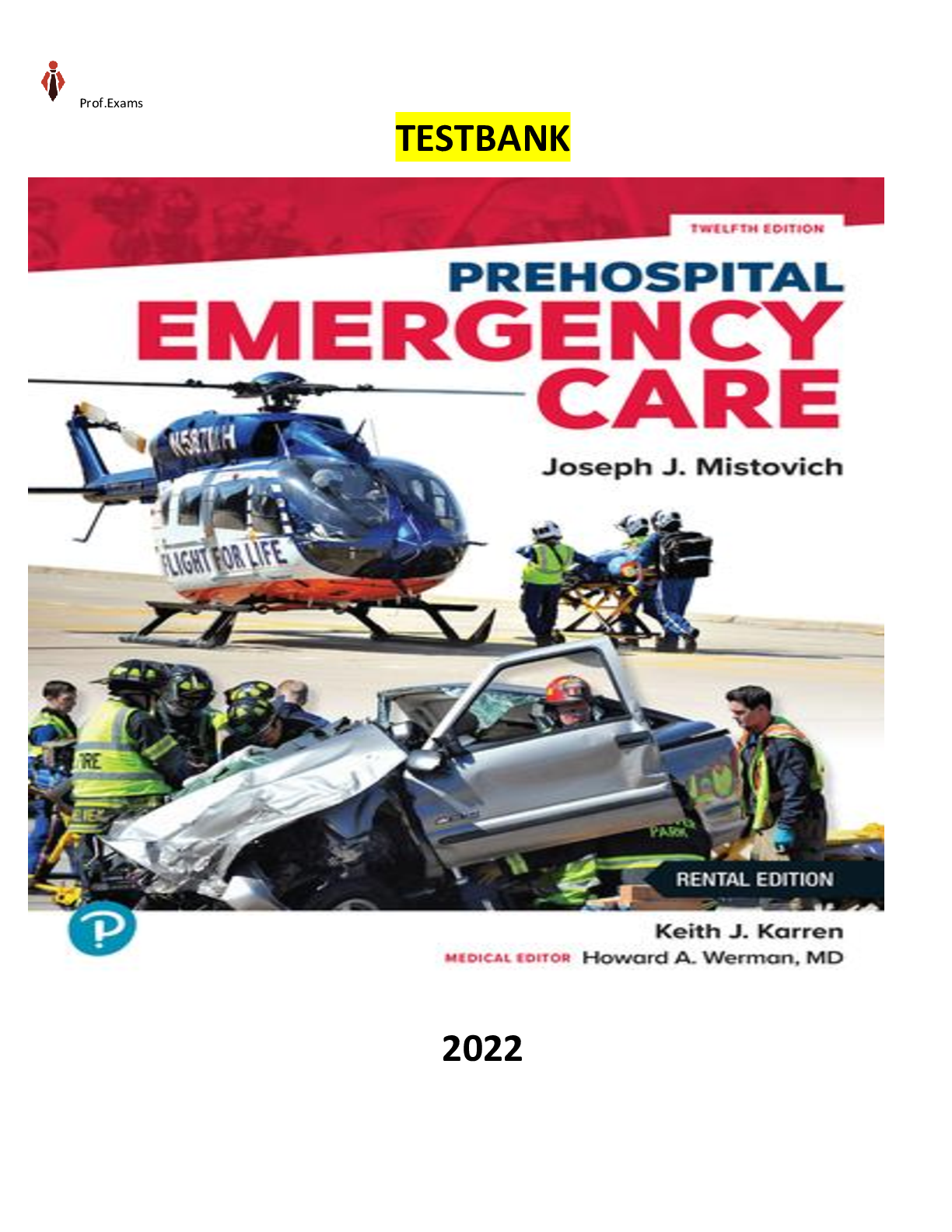
Instant download
Reviews( 0 )
Document information
Connected school, study & course
About the document
Uploaded On
Mar 26, 2023
Number of pages
785
Written in
Additional information
This document has been written for:
Uploaded
Mar 26, 2023
Downloads
0
Views
49

